#oxana skorik
Text
Some of My Favorite Odiles!!
Here are some of my absolute favorite Odiles! I really had to stop myself from adding waayyy too many dancers to this list. Feel free to let me know other dancers that you guys love in this role!!
youtube
Ulyana Lopatkina
youtube
Viktoria Tereshkina
youtube
Svetlana Zakharova
youtube
Oxana Skorik
youtube
Gillian Murphy
youtube
Polina Semionova
#ballet#swan lake#odile#ulyana lopatkina#viktoria tereshkina#svetlana zakharova#oxana skorik#gillian murphy#polina semionova
35 notes
·
View notes
Note
What do you think about Oksana Skorik? I really admire her lines but I’ve also heard some people say she’s not very good so I wondered what you think as a professional :)
See I’m personally a big admirer of her, especially her interpretations of O/O, Nikiya, and other dramatic roles. Every time I’ve seen her live, I’ve been in tears. That doesn’t happen very often.
Honestly, I think a lot of her critics haven’t really watched her dance in a hot minute. Because young Oksana compared to current Oksana are completely different dancers. Her transition from student to professional was rocky and rushed. In addition to her eating disorder and her abusive undergraduate teacher, she had a target on her back instantly after being hired by MT, people were like “Um who is this skinny girl they found in Perm and why is she already a coryphee instead of our VBA grads”. The pressure on her must have been enormous, she had quite a few shaky early performances. Although her raw ability was clear, Balletomanes were puzzled because her rough solo roles got rewarded with greater instability in principal parts and a first soloist promotion. It took her a while to find her footing as a professional.
Even now, although she's much more mature, she does seem to be a more 'hit and miss' type of dancer. Not every show she dances is going to be her best and some still find her very cold and unmoving on stage. I'll have to hunt for an old interview she gave where she describes herself as a very emotional person, and she acknowledges that definitely influences her dancing both consciously and subconsciously. There's that and then there are also those who clearly aren't a fan of her personality which I obviously can't speak to.

14 notes
·
View notes
Photo
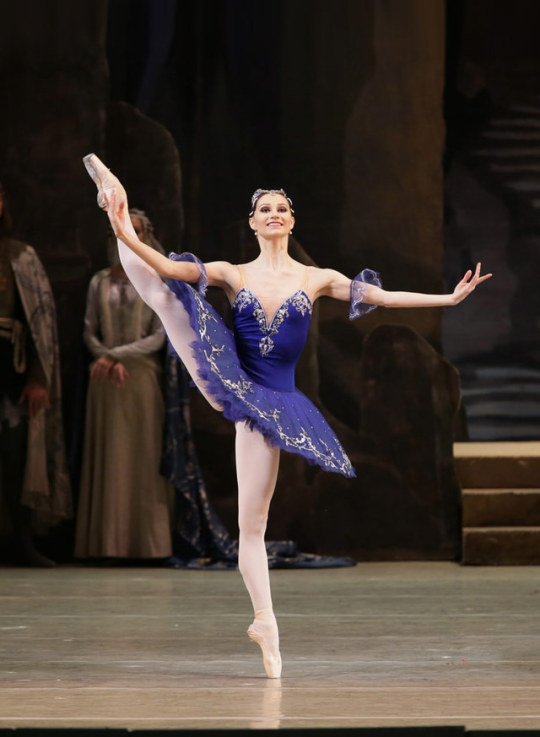
Oxana Skorik in Raymonda, Mariinsky Ballet, February 2016. © Valentin Baranovsky.
Just recently promoted to the principal ranks, Skorik has an exquisite body and her technical skills are truly impressive. She had a few rough moments in the beginning of the ballet, but came into her own in the pure-dance final act, nailing every step.
23 notes
·
View notes
Photo
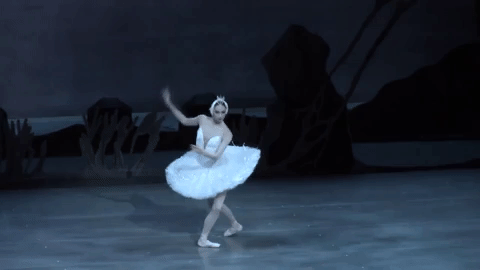

Oxana Skorik in Swan Lake (Mariinsky Ballet)
#oxana skorik#Mariinsky Ballet#mariinsky#swan lake#white swan#ballet#dance#gifs#my gif#oksana skorik
563 notes
·
View notes
Photo
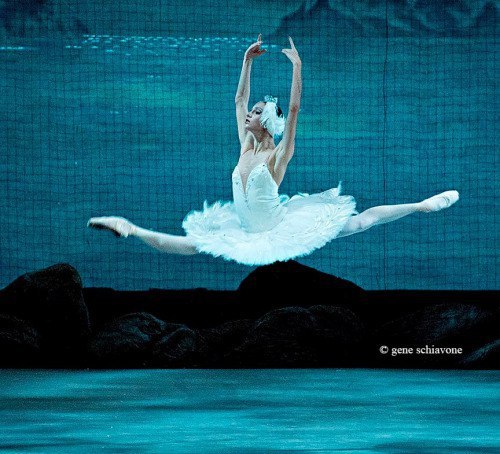

Oxana Skorik & Timur Askerov in Mariinsky’s Swan Lake.
Photos by Dave Morgan.
#oxana skorik#oksana skorik#timur askerov#dave morgan#mariinsky#mariinsky theatre#mariinsky ballet#swan lake#ballet#ballerina
13 notes
·
View notes
Text
Opinion on Dancers
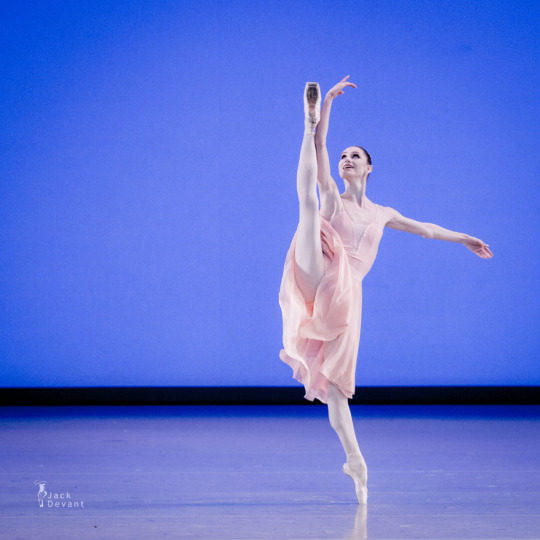
What do you think of Oksana Skorik?
To put it simply, I understand why so many people have a problem with Skorik, but I think that the amount and level of hatred often directed at her is ridiculous and completely unacceptable.
Interestingly enough, I read The New Yorker article about Diana Vishneva the other day, which points out the issue Westerners often have with Russian ballerinas. I think this quote nails Oksana’s main issue:
“No matter how large-scaled her acting, though, she always looked sincere. That’s her deviation from the practice of many Russian ballerinas today. How hard they can be! Over-rehearsed, over-styled, lacquered—bronzed. Some people like that in the Russians. It makes them feel they got their money’s worth. To me, it’s camp. Vishneva manages to be extreme and relaxed simultaneously. She has a good time.”
I doubt whether Oksana ever has good time on stage. Or away from it. On many levels I understand and sympathise with her angst (I wasn’t a particularly happy child myself, and “Beautiful Tragedy” resonated with me), but the one thing I’ve learned in the last few years of following ballet and interviewing some of the VBA students, is that attitude has a tremendous effect on the quality of a dancer’s performance and their overall success.
I understand Fateyev’s and/or Gergiev’s motivation behind promoting her to the status of prima (a move which upset many). The fact that Oksana hasn’t always delivered the goods doesn’t have anything to do with her talent - she’s a gifted ballerina - but rather with whatever loomy gloom she’s swimming in*.
I know that questions like these normally require some sort of analysis of the dancer’s technique, musicality, and so on, but I honestly don’t feel like pointing out Oksana’s faults. There are already plenty of other people who delight in doing that. Instead, I wanted to offer my opinion on the significance of a dancer’s emotional and mental health, and the effect these have on their performance**.
Oksana is having a shit year. Her beloved cat has died very suddenly and now she has (reportedly) suffered a bad injury. People need to send her some good vibes. For a change.

*Award yourself 50 points if you got the “Adventure Time” reference.
**After re-reading my response I realised that I appear to be speaking with a little too much authority on the state of Skorik’s mental and emotional health. Just to clarify: I do not know her personally but, like a great number of people, I have picked up on Oksana’s gloomy vibe. It isn’t my intention to patronise her. I’m writing from a place of solidarity and concern.
d i s c l a i m e r
15 notes
·
View notes
Photo
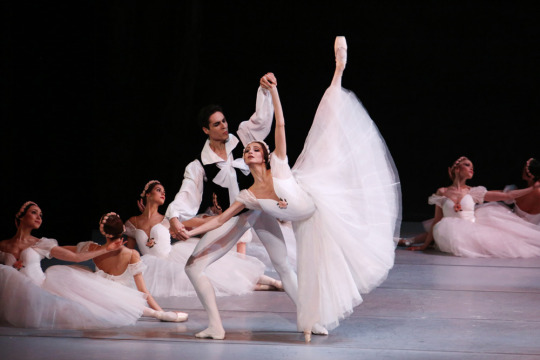
Oxana Skorik and Timur Askerov in Chopiniana (Mariinsky Ballet, 2015)
38 notes
·
View notes
Text
Saved by the corps! The Mariinsky under par for Swan Lake in Turin
Philipp Stepin in Swan Lake by Natasha Razina © State Academic Mariinsky Theatre The buzz of anticipation in the theatre wasn’t matched by the Mariinsky Ballet’s presentation on Saturday afternoon in Turin’s Teatro Regio. Maybe because it was the ‘pensioners’ matinée’, the company decided not to field their top players. For the Mariinsky, the performance was under par. The first technical feats…
View On WordPress
1 note
·
View note
Photo

BALLET / 2018-2019
LE CORSAIRE
STUDENT GUIDE
WORKING REHEARSAL
MARIINSKY BALLET
With the Kennedy Center Opera House Orchestra
Original Choreography by Marius Petipa
Reconstructed choreography (1987) by Pyotr Gusev
Music by Adolphe Adan, Cesare Pugni, Léo Delibes, Riccardo Drigo and Pyotr Oldenburgsky
Libretto by Henri Vernoy de Saint-Georges and Joseph Mazilier and edited by Yuri Slonimsky and Pyotr Gusev
School Show: April 9
Teacher and Parent Guide: Le Corsaire
Before the curtain rises, a little history…
Whether or not you’ve touched a tutu or performed a plié, you’ve surely heard of Marius Petipa’s (pronounced PET-ee-pahs) ballets. Does Swan Lake ring any bells? What about Sleeping Beauty? And that holiday classic, The Nutcracker! But here’s the oddest thing: Petipa—born in France—is considered the “Father of Russian Ballet.” How’d that happen?
When Petipa arrived in St. Petersburg, Russia in 1847, he was considered just an “okay” dancer. Decades later, however, he had successfully danced his way up the ladder at the Russian Imperial Theatre. To celebrate this famous choreographer, the Mariinsky Ballet performs Le Corsaire (COUR-sair, The Pirate). Set on an island in Greece, this ballet is filled with exotic characters, a shipwreck, treachery, romance, betrayal, and a boatload of pirates!
About that pirate ballet…
The story of Le Corsaire was loosely adapted from Lord Byron’s poem of the same name. The first production was choreographed by Joseph Mazilier in 1856, but Mariinsky’s version is a reconstruction of Marius Petipa’s choreographic revival about 10 years later.
Now here’s the interesting part: Petipa didn’t just choreograph one production of Le Corsaire. He actually revived it four times—each time adding more pas (pronounced pah, incidental dance variations that don’t necessarily forward the plotline or character development). This shouldn’t come as a big surprise since Petipa was famous for developing the form of the grand ballet—a multi-act production with a fully-developed plot, pantomime acting, and lavish sets and costumes. And you’ll soon see that Le Corsaire absolutely fits that definition.
Who’s Who
Main Characters
Conrad, Birbanto, and Ali: shipwrecked pirates
Medora: the most beautiful woman on the Greek island
Gulnara: Medora’s friend
Lankedem: an evil slave trader
Seid Pasha: a rich sultan
So, What’s Going On?
Prologue: The Shipwreck
Three corsairs (“pirates” in French) struggle to save their boat during a storm. Their efforts fail and the boat sinks.
Act I
Scene 1: The Sea Shore
Shipwrecked on a Greek island, the corsairs named Conrad, Ali, and Birbanto are saved by a group of young women. If found by the Turkish patrols, the men will be in immediate danger. The women decide to hide them as one of the women, Medora, falls in love with Conrad. Meanwhile, Lankedem, an evil slave trader, is pillaging the Greek coast in search of women to seize and sell. The women successfully hide the corsairs but are captured by Lankedem’s men.
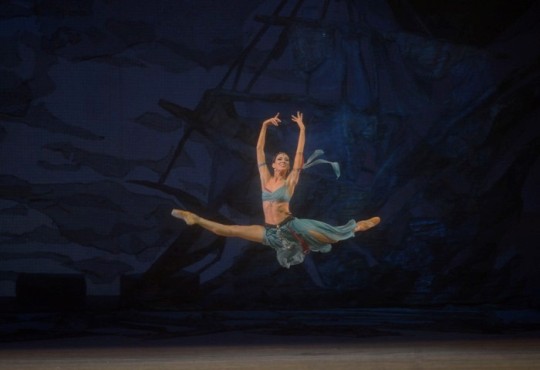
Caption: Mariinsky dancers are renowned for their impeccable technique and their focus on storytelling.
Credit: Viktoria Tereshkina in Le Corsaire by Valentin Baranovsky ™ State Academic Mariinsky Theatre
Scene 2: The Slave Market
From his powerful throne in the marketplace, the sultan Seid Pasha is eager to add young women to his harem. Lankedem is equally enthusiastic to fill the sultan’s wish and sells Medora’s friend Gulnara to him. Then, just as Medora is brought in, another bidder enters the market area—the pirate Conrad in disguise. When Seid Pasha confronts Conrad, the other corsairs throw off their cloaks, seize the evil Lankedem, and rescue the women. The Seid Pasha is furious at the useless Turkish patrol.

Caption: Pas (incidental dance variations) are common in Petipa ballets. While these dance variations might not move the plot forward, they still help the audience better understand the characters.
Credit: David Zaleyev in Le Corsaire by Natasha Razina ™ State Academic Mariinsky Theatre
Act II: The Corsairs’ Cave
The corsairs cheer the rescued women as well as the money they stole from the sultan. In celebration, Medora dances with Conrad and his friend Ali. The other women, however, express to Medora their desire to return home to their villages. Birbanto wants the women to stay, but Conrad is convinced by Medora to take the women home. Lankedem watches this conflict grow between Conrad and Birbanto. In exchange for his freedom, he offers Birbanto a sleeping potion. The plan is for Birbanto to pour the potion on a bouquet of flowers and give it to Medora. Medora passes the flowers to Conrad to thank him for his chivalry. Conrad falls asleep as Lankedem abducts Medora and he escapes the cave.
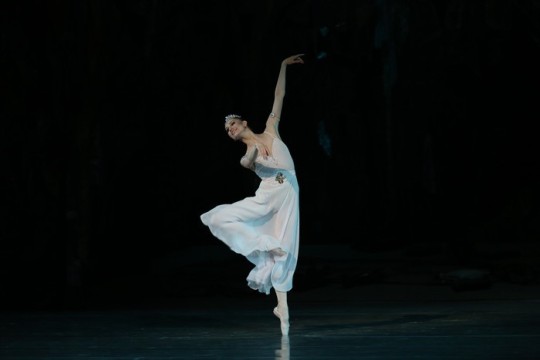
Caption: Medora is considered the most beautiful woman on the island; her movements are graceful and virtuosic.
Credit: Oxana Skorik in Le Corsaire by Natasha Razina ™ State Academic Mariinsky Theatre
Act III: The Seid Pasha’s Harem
Lankedem brings Medora to Seid Pasha’s harem, where he eagerly buys her from the slave trader and celebrates his new prize in his “garden of beauties.” Suddenly, mysterious pilgrims enter the palace and are invited to join the evening prayer. But Medora recognizes the visitors to be the corsairs, once again in disguise. The pirates surprise attack Lankedem’s patrol and Conrad saves Medora once and for all.
Epilogue
Medora, Conrad, and their friends sail toward their next adventure.
Check This Out…
Everything about this production is grand—from the spectacular sets and ornate costumes to the challenging choreography and large cast of dancers. The intricate plot calls for such grandeur, but it is also a famous quality of the Mariinsky company itself. Let’s take a closer look at what makes this production so impressive.
What to Look for:
SETS
The sets in Le Corsaire feature spectacular backdrops, curtains, and panels that set the scene without taking up the dancers’ real estate on the stage. There are a couple of scenes (including the slave auction) where there is a small platform on stage. But for the most part, the stage is wide open. This allows for a large number of dancers to be on stage and for them to perform dynamic, traveling choreography. This is particularly noticeable in the opening of Act II where the corsairs and women are celebrating.

Caption: A scene inside the elaborate cave setting.
Credit: Viktoria Tereshkina & Andrei Yermakov in Le Corsaire by Valentin Baranovsky ™ State Academic Mariinsky Theatre
COSTUMES
The costume design in Le Corsaire fuses Eastern-inspired apparel like harem pants and intricately wrapped stomach baring tops, with more traditional ballet apparel and accessories, including grand tutus and leotards and tights. Both the men and the women are dressed from head to toe. Headpieces and hats, facial hair and wigs, jewelry, and specially crafted shoes all reinforce characterization in Le Corsaire.
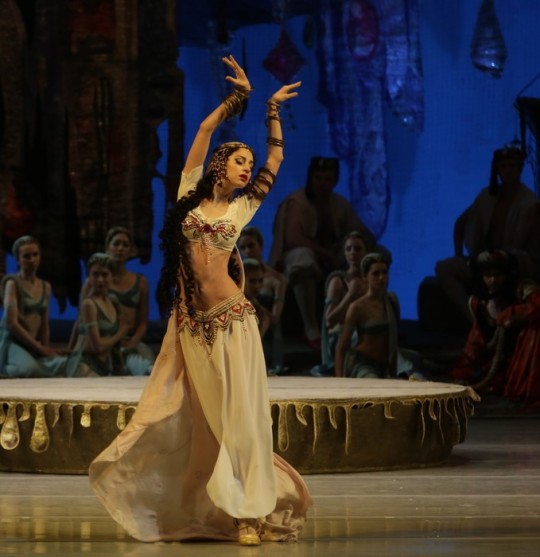
Caption: The costumes in Le Corsaire are extremely detailed and ornate—from the dancer’s headpiece and hairstyle to the pattern on her shoes.
Credit: Olga Belik in Le Corsaire by Natasha Razina ™ State Academic Mariinsky Theatre
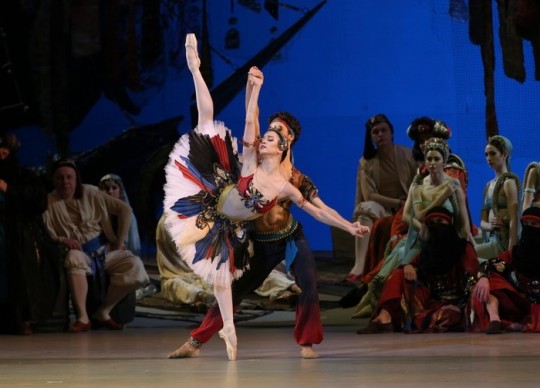
Caption: The costume design fuses traditional ballet tutus and pointe shoes with more Eastern inspired apparel.
Credit: Renata Shakirova & David Zaleyev in Le Corsaire by Natasha Razina ™ State Academic Mariinsky Theatre
CHOREOGRAPHY
Le Corsaire features both virtuosic choreography as well as elaborate pantomime. In fact, the character of Conrad initially didn’t dance at all—he only acted through pantomime.
Pay attention to the height of their jétes (zhuh-TAYS, jumps), intricate pirouettes (peer-WET, whirls or spins sequences), and effortless athleticism. Additionally, the corps de ballet (core duh bah-LAY, dancers in a company that perform as a group) demonstrates its unity of style.
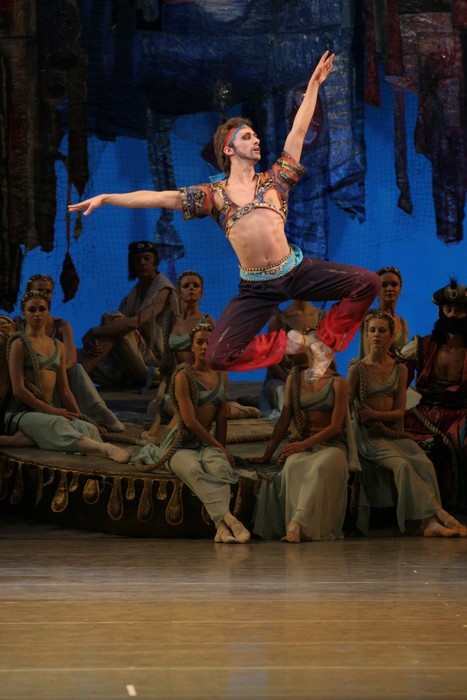
Caption: Years of training allows this dancer to travel through the air with amazing flexibility and height, making this difficult jump look effortless.
Credit: Philipp Stepin in Le Corsaire by Natasha Razina ™ State Academic Mariinsky Theatre
Additionally, Mariinsky dancers have distinguished themselves for their beautiful port de bras (pawr duh BRAH, technique of moving arms gracefully) and epaulement (ay-pohl-MAHN, placing of the shoulders and head). This meticulous attention to expression, fluidity, and detail gives a sense of aristocratic elegance.

Caption: The corps de ballet often works as a backdrop to the principal dancers.
Credit: Renata Shakirova in Le Corsaire by Natasha Razina ™ State Academic Mariinsky Theatre
The female dancers don’t always wear pointe shoes. They perform the more folkloric choreography in character shoes with a short heel.
Pantomime is a major element of Le Corsaire. It often helps to set the scene but is also incorporated into much of ballet choreography. For example, watch how Seid Pasha’s movements and gestures tell much about his intentions. Another dramatic moment of pantomime is when Conrad smells the bouquet of poisoned flowers at the end of Act II.
What to Listen for:
The score for Le Corsaire is a hodgepodge of tunes from many ballet composers, the result of scenes added over many years by Petipa. The “legend” is that ballerinas would often demand “a special solo” be added whenever they entered a production. Over time, each favorite solo became part of the standard version. In fact, ballets like Corsaire, (which didn’t start with a strong central score like Swan Lake and The Sleeping Beauty), were often subject to these kinds of musical additions.
Listen closely. Some music seems more Eastern Greek-inspired with accents from tambourines and flutes while other compositions sound like they may have come from another ballet like Swan Lake or The Sleeping Beauty.
What to Think About:
Le Corsaire has been performed internationally for over 250 years. Why do you think it remains so popular?
How is Le Corsaire similar to ballets you might have seen in the past? Can you make a list of qualities common among Petipa’s ballets or other classical ballets?
“Seeing a ballet” means more than simply watching dancers dance. A ballet is a total theatrical production with all parts working together, from the sets and costumes to the music and choreography. Think about how seeing Le Corsaire has changed your perception of ballet.
Let’s Talk About Shoes
In Le Corsaire, the ballerinas perform in both pointe shoes and heeled shoes. For some background info, here’s a bit of history behind the evolution of the ballet shoe.
Ballet and pointe shoes might seem inseparable today, but the art of ballet actually came about 200 years before ballerinas began dancing on their tiptoes. The Royal Academy of Dance was founded in France by King Louis XIV in the mid-seventeenth century. While ballet was practiced all throughout Europe, this Academy helped codify the language of the art form (which is why ballet terminology is in French). As ballet grew out of the social court dances, both male and female dancers wore heeled shoes (as you’ll see many dancers wear in the start of Act II). As you can imagine, heels inhibited a lot of movement. The heel was “dropped” in the early eighteenth century; the more formal shoe allowed for greater articulation of the foot (think of demi-pointe/soft ballet slippers that we have today).
By the late eighteenth century, choreographers began experimenting with wires and harnesses to elevate dancers from “mortal to ethereal.” Dancers also began stuffing their shoes with padding to get higher and higher on relevé (reh-luh-VAY, a raised body). Soon after, alterations were made to the shoes themselves to make this toe work more possible. The pointed-tip shoes were swapped with a sturdy front platform, or a layered fabric “box” to encase the toes, and a stiffer (but silent) sole. What we consider “modern day” pointe shoes are even stronger and sturdier than those early versions.
Surprisingly, the pointe shoe has remained relatively unchanged over the past 200 years despite the increasing demands of modern ballet dancing. A professional ballerina can wear up to 120 pairs of pointe shoes in a year and will often “alter” her shoes depending on a particular role (breaking them in more or stiffening them to last longer). Dance shoe companies provide the pointe shoes—the tools for the art—but it is often the dancer’s responsibility to mold and shape the shoes to fit her needs (and to care for her feet with tape, toe pads, etc.).
Learn more about the pointe shoe with this ARTSEDGE resource.
Take Action: Tell Your Story
Classical ballets were generally based off well-known fairy tales, fables, and folklore. Some examples are The Sleeping Beauty, Romeo and Juliet, and Swan Lake. Le Corsaire follows this model in the story elements of a shipwreck, a sleeping potion, and a happily-ever-after ending.
Think of a well-known story you especially enjoy—anything from the Three Little Pigs to Spider-Man. Either by yourself or with a group of classmates or friends, tell your story through movement using choreography and/or pantomime. Like a game of charades, communicate your tale without speaking. If you choose to present your work to your class or family, see if they can guess the story you’ve chosen to tell.
EXPLORE MORE
Go even deeper with the Le Corsaire Extras.
-
Top Photo: Le Corsaire by Valentin Baranovsky™ State Academic Mariinsky Theatre
Writer: Mary Callahan
Content Editor: Lisa Resnick
Logistics Coordination: Katherine Huseman
Producer and Program Manager: Tiffany A. Bryant
-

David M. Rubenstein
Chairman
Deborah F. Rutter
President
Mario R. Rossero
Senior Vice President
Education
Support for Ballet at the Kennedy Center is generously provided by Elizabeth and C. Michael Kojaian.
International Programming at the Kennedy Center is made possible through the generosity of the Kennedy Center International Committee on the Arts.
Major support for educational programs at the Kennedy Center is provided by David M. Rubenstein through the Rubenstein Arts Access Program.
Kennedy Center education and related artistic programming is made possible through the generosity of the National Committee for the Performing Arts.
© 2019 The John F. Kennedy Center for the Performing Arts
0 notes
Text
Giselle - 1841
POR VIVIANE SANTOS

Seguindo nossa série de posts sobre a história da dança, hoje eu vou contar um pouco sobre o ballet Giselle. Um ballet lindíssimo que segue a linha dos ballets blancs. Ele estreia em 28 de junho de 1841 e foi a apoteose do ballet romântico. Todas as bailarinas dançam nas pontas, diferente de La Sylphide, onde somente a solista dançava nas pontas. É um ballet em dois atos, com música de Adophe Adam. Giselle foi o primeiro ballet a ter música composta só para ele.
O roteiro foi escrito por Théophile Gautier (poeta, dramaturgo, escritor e crítico de arte da época) e conta a historia de Giselle, uma camponesa que se apaixona por Albrecht, um nobre disfarçado de camponês. Ela descobre que ele a traiu e morre de desgosto após essa desilusão amorosa. O segundo ato destaca as Willis, personagens místicas que representam os espíritos das jovens virgens que morreram nas vésperas de se casarem. Elas estão vestidas de noiva e com anel no dedo. A ideia das Willis vem de um conto “De l’Allemagne” de Henri Heine. No conto de Heine, as Willis eram espíritos vestidos de branco que dançam por toda a noite.
Conta a lenda das Willis que à meia-noite elas se levantam de seus túmulos e sempre que um homem se aproxima delas, elas o obrigam a dançar até a morte. Giselle, ainda apaixonada, salva o amado das Willis e de Mirtha, sua rainha, se oferecendo a dançar no lugar dele. Com isso, ela quebra o encanto das Willis. Giselle o perdoa no final da peça.
O papel principal de Giselle foi escrito por Gautier para Carlotta Grisi. Este papel exige muita técnica, graça e lirismo. Carlotta Grisi foi uma bailarina italiana que se tornou famosa por sua performance em Giselle. (prometo fazer um post mais pra frente contando a historia de Carlotta Grisi.... rsrsrs). A coreografia foi criada por Jean Coralli, mestre sênior da Opera de Paris e as partes de Grisi foram desenvolvidas por Jules Perrot. Embora não conste seu nome nos registros do ballet, a historia conta que ele foi o criador destas partes.
A montagem que conhecemos hoje não é a mesma deste tempo. As versões que conhecemos são baseadas na versão de Petipa, de 1884. A versão dançada pelo Mariinsky ballet é a mais próxima da versão de Petipa.
Personagens:
Giselle: Jovem camponesa.
Albrecht: Duque da Silesia que finge ser um simples fazendeiro chamado “Loys”.
Hilarion: Camponês, protetor da floresta, apaixonado por Giselle.
Wilfrid: o escudeiro do Duque.
Bertha / Berthe: Mãe de Giselle.
Príncipe de Courtland.
Bathilde / Bathilda: Filha do Príncipe de Courtland, noiva de Albrecht.
Myrtha: Rainha das Wilis.
Zulma: Uma Wili.
Moyna / Monna: Uma Wili.
Fonte: http://lojaanabotafogo.com.br/giselle-ou-les-wilis/
Oxana Skorik (Atual Prima Ballerina do Mariinsky Ballet) dançando Giselle
youtube
Svetlana Zakharova e Roberto Boole dançando Giselle
youtube
0 notes
Video
Review 2019 - The Dance Year from Dance Europe on Vimeo.
A collage featuring some of the wonderful dancers and companies photographed by Dance Europe during the past 12 months.
Photographs:
The Nutcracker, Mariinsky Ballet - Kimin Kim and Maria Khoreva; Le Parc ch: Angelin Preljocaj- Alessandra Ferri and Herman Cornejo; Beauty and The Beast ch: David Bintley, Birmingham Royal Ballet - Delia Mathews and Tyrone Singleton; Yaoqian Shang; Faun ch: Sidi Larbi Cherkaoui, Paris Opera - Juliette Hilaire and Marc Moreau; Les Noces ch: Pontus Lidberg, Paris Opera; Blue Moon ch: Aletta Collins, The Royal Ballet; Odissi Solo - Mavin Khoo; What is BirdGang? - BirdGang; Don Quixote pr: Carlos Acosta, The Royal Ballet - Marianela Nuñez; Swan Lake pr: Nureyev, Paris Opera - Germain Louvet and François Alu; Léonore Baulac and Germain Louvet; Bon Voyage, Bob... ch: Alan Lucien Øyen - Tanztheater Wuppertal Pina Bausch; Hotel - Cirque Éloize; Swan Lake, Dutch National Ballet - Maia Makhateli and Daniel Camargo; Le Reveil de Flore - Mariinsky Ballet; Frankenstein ch: Liam Scarlett, The Royal Ballet - Federico Bonelli and Wei Wang; Russian Ballet Icons Gala - Marcelino Sambé; Julian MacKay; Romeo and Juliet ch: MacMillan, The Royal Ballet - Lauren Cuthbertson; Victoria ch: Cathy Marston, Northern Ballet - Pippa Moore; Marguerite and Armand ch: Ashton, Mariinsky Ballet - Diana Vishneva and Xander Parish; Push Comes to Shove ch: Twyla Tharp, Mariinsky Ballet - Victor Caixeta; Canto de Ossanha ch: Joonhyuk, The Royal Ballet; Medusa ch: Sidi Larbi Cherkaoui - Natalia Osipova and Matthew Ball; Don Quixote, Mariinsky Ballet - Elena Yevseyeva and Victor Caixeta; Maria Khoreva; Mayerling ch: MacMillan, Stuttgart Ballet - Friedemann Vogel; Giselle, Abay Kazakh Ballet; The Birds ch: MacMillan, Central School of Ballet; My First Ballet: Sleeping Beauty, English National Ballet School; The Great Gatsby ch: David Nixon - Kevin Poeung and Ashley Dixon; Mayerling ch: MacMillan - Marcia Haydée and Egon Madsen; The Two Pigeons, Paris Opera Ballet School; Dracula ch: David Nixon - Javier Torres and Antoinette Brooks-Daw; The Sleeping Beauty, Mariinsky Ballet - Xander Parish; YAGP New York, Grand Prix recipient - Gabriel Figueredo; Hummingbird ch: Liam Scarlett - San Francisco Ballet; Cinderella ch: Christopher Wheeldon - Emma Hawes and Katja Khaniukova; Alina Cojocaru and Isaac Hernández; Birthday Offering ch: Ashton, The Royal Ballet - Fumi Kaneko; Coppélia ch: de Valois, The Royal Ballet - Gary Avis; YAGP Paris, Grand Prix recipient António Casalinho; Don Quixote, Mariinsky Ballet, Chloë Réveillon; Dracula ch: David Nixon, Northern Ballet - Kevin Poeung and Joseph Taylor; Paquita, Dutch National Ballet Academy - Emma Mardegan and Philippe Magdelijns; The Nutcracker, English National Ballet - Matthew Astley; The Firebird, The Royal Ballet - Yasmine Naghdi; Raymonda, pr: Nureyev, Paris Opera - Dorothée Gilbert and Hugo Marchand; Giselle, Birmingham Royal Ballet - Momoko Hirata and Cesar Morales; Giselle, Mariinsky Ballet - May Nagahisa; Dada Masilo’s Giselle; Legend of Love, The Mariinsky Ballet - May Nagahisa and Timur Askerov; Manon ch: MacMillan, The Royal Ballet - Francesca Hayward; Cinderella, Christopher Wheeldon, English National Ballet - Shale Wagman; Rasputin, Polunin Ink - Sergei Polunin and Johan Kobborg; Raymonda, The Royal Ballet - Vadim Muntagirov; Powerhouse Rhumba ch: David Nixon - Abigail Prudames and Joseph Taylor; Bespoke ch: Stanton Welch, San Francisco Ballet - Angelo Greco; Spartacus ch: Grigorovich, Bolshoi Ballet - Anastasia Denisova and Denis Rodkin; A Month in the Country ch: Ashton, The Royal Ballet - Vadim Muntagirov; Swan Lake, Mariinsky Ballet - Oxana Skorik and Xander Parish; Boléro ch: Mats Ek, Paris Opera - Niklas Ek; The Red Shoes ch: Matthew Bourne, New Adventures - Ashley Shaw and Adam Cooper; Cinderella ch: David Nixon, Northern Ballet - Ashley Dixon. © Emma Kauldhar 2019.
Photos of The Royal Ballet courtesy of the Royal Opera House.
Curtain Calls
Dutch National Ballet, Gala, National Opera and Ballet, Amsterdam
Mariinsky Ballet, Don Quixote, Mariinsky Theatre, St Petersburg
Abay Kazakh Ballet, Rediscovering Bach/Boléro, Almaty
Paris Opera, Raymonda, Opera Bastille, Paris
Bolshoi Ballet, Don Quixote, Royal Opera House, London
Mariinsky Ballet, The Nutcracker and Marguerite and Armand
Mariinsky Theatre, St Petersburg
Music - ‘An Orchestra’ licensed by Envato
0 notes
Note
Favorite ballerinas in the Mariinsky?
My favorites at the Mariinsky overall are Novikova, Osmolkina, Skorik, and Shakirova. Also, Vishneva is obviously a legend, just not dancing much anymore. Finally, Ilyushkina and Khoreva are my favorite up-and-comers.
#mariinsky#mariinsky ballet#ballet#olesya novikova#ekaterina osmolkina#oxana skorik#renata shakirova#diana vishneva#maria ilyushkina#maria khoreva#favorite ballerinas#ballerinas
2 notes
·
View notes
Note
Hi Ale, I don't know if it's just me, but sometimes I wish Oksana Skorik went to be a principal at the Bolshoi. I don't know what issue the Mariinsky and it's audience has with her, but they never truly accepted her and in my eyes, she's the best dancer in the company. But every time she's in the BT, I see her getting so much praise. I don't know if this has ever been a possibility or if it will ever be...
Ooof I think I'll have to disagree with this one. Although it's true that Oksana had a difficult start at MT and she's certainly not the 'fan favorite,' I don't think she's a stylistic match for BT and I wouldn't want her to go there. If she had to leave, I'd rather send her somewhere in Europe.
The Bolshoi aesthetic has long rewarded dancers who are larger than life, with both explosive movement qualities and outward tendencies for drama and fanfare. Oksana is a much more internal performer, some say she's even too reserved facially and find her cold. I think when she guests for a Moscow event or a BT gala, people know what they're getting, a more self-contained, restrained SPB-style performance. But I think part of the magic of Skorik is how enchantingly aloof her movements are, and I'm not convinced that her style would resonate long-term on the Bolshoi stage.
#oksana skorik#oxana skorik#ballet#ballet ask#ballerina#bolshoi ballet#bolshoi theatre#mariinsky ballet#mariinsky theatre
14 notes
·
View notes
Photo
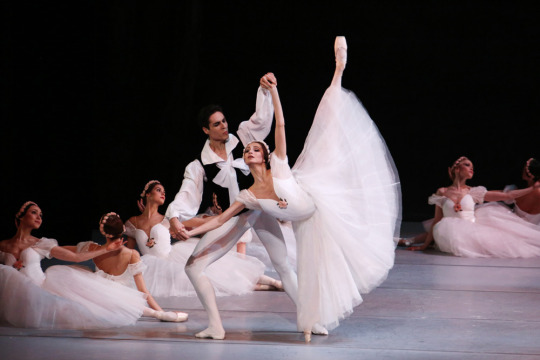
Oxana Skorik and Timur Askerov in Michel Fokine’s Chopiniana, Mariinsky Ballet, New York, January 2015. © Julieta Cervantes.
Askerov, the Poet/Dreamer, danced impeccably, and his partnering was secure. But his demeanor was more stoic than dreamy. Skorik, who danced the pas de deux with him, danced stiffly at first and seemed relatively uncomfortable with a flat expression – nothing, not even serenity, radiating from her face.
34 notes
·
View notes
Photo
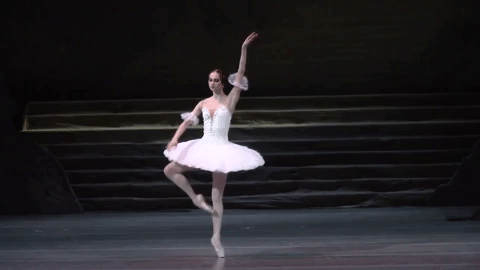

Oxana Skorik in Raymonda (Mariinsky Ballet)
206 notes
·
View notes
Video
vimeo
Titel: Review 2019 - The Dance Year Text: A photographic collage recalling some of the wonderful dancers and ballets photographed by Dance Europe during the last 12 months. Photographs: The Nutcracker, Mariinsky Ballet - Kimin Kim and Maria Khoreva; Le Parc ch: Angelin Preljocaj- Alessandra Ferri and Herman Cornejo; Beauty and The Beast ch: David Bintley, Birmingham Royal Ballet - Delia Mathews and Tyrone Singleton; Yaoqian Shang; Faun ch: Sidi Larbi Cherkaoui, Paris Opera - Juliette Hilaire and Marc Moreau; Les Noces ch: Pontus Lidberg, Paris Opera; Blue Moon ch: Aletta Collins, The Royal Ballet; Odissi Solo - Mavin Khoo; What is BirdGang? - BirdGang; Don Quixote pr: Carlos Acosta, The Royal Ballet - Marianela Nuñez; Swan Lake pr: Nureyev, Paris Opera - Germain Louvet and François Alu; Léonore Baulac and Germain Louvet; Bon Voyage, Bob... ch: Alan Lucien Øyen - Tanztheater Wuppertal Pina Bausch; Hotel - Cirque Éloize; Swan Lake, Dutch National Ballet - Maia Makhateli and Daniel Camargo; Le Reveil de Flore - Mariinsky Ballet; Frankenstein ch: Liam Scarlett, The Royal Ballet - Federico Bonelli and Wei Wang; Russian Ballet Icons Gala - Marcelino Sambé; Julian MacKay; Romeo and Juliet ch: MacMillan, The Royal Ballet - Lauren Cuthbertson; Victoria ch: Cathy Marston, Northern Ballet - Pippa Moore; Marguerite and Armand ch: Ashton, Mariinsky Ballet - Diana Vishneva and Xander Parish; Push Comes to Shove ch: Twyla Tharp, Mariinsky Ballet - Victor Caixeta; Canto de Ossanha ch: Joonhyuk, The Royal Ballet; Medusa ch: Sidi Larbi Cherkaoui - Natalia Osipova and Matthew Ball; Don Quixote, Mariinsky Ballet - Elena Yevseyeva and Victor Caixeta; Maria Khoreva; Mayerling ch: MacMillan, Stuttgart Ballet - Friedemann Vogel; Giselle, Abay Kazakh Ballet; The Birds ch: MacMillan, Central School of Ballet; My First Ballet: Sleeping Beauty, English National Ballet School; The Great Gatsby ch: David Nixon - Kevin Poeung and Ashley Dixon; Mayerling ch: MacMillan - Marcia Haydée and Egon Madsen; The Two Pigeons, Paris Opera Ballet School; Dracula ch: David Nixon - Javier Torres and Antoinette Brooks-Daw; The Sleeping Beauty, Mariinsky Ballet - Xander Parish; YAGP New York, Grand Prix recipient - Gabriel Figueredo; Hummingbird ch: Liam Scarlett - San Francisco Ballet; Cinderella ch: Christopher Wheeldon - Emma Hawes and Katja Khaniukova; Alina Cojocaru and Isaac Hernández; Birthday Offering ch: Ashton, The Royal Ballet - Fumi Kaneko; Coppélia ch: de Valois, The Royal Ballet - Gary Avis; YAGP Paris, Grand Prix recipient António Casalinho; Don Quixote, Mariinsky Ballet, Chloë Réveillon; Dracula ch: David Nixon, Northern Ballet - Kevin Poeung and Joseph Taylor; Paquita, Dutch National Ballet Academy - Emma Mardegan and Philippe Magdelijns; The Nutcracker, English National Ballet - Matthew Astley; The Firebird, The Royal Ballet - Yasmine Naghdi; Raymonda, pr: Nureyev, Paris Opera - Dorothée Gilbert and Hugo Marchand; Giselle, Birmingham Royal Ballet - Momoko Hirata and Cesar Morales; Giselle, Mariinsky Ballet - May Nagahisa; Dada Masilo’s Giselle; Legend of Love, The Mariinsky Ballet - May Nagahisa and Timur Askerov; Manon ch: MacMillan, The Royal Ballet - Francesca Hayward; Cinderella, Christopher Wheeldon, English National Ballet - Shale Wagman; Rasputin, Polunin Ink - Sergei Polunin and Johan Kobborg; Raymonda, The Royal Ballet - Vadim Muntagirov; Powerhouse Rhumba ch: David Nixon - Abigail Prudames and Joseph Taylor; Bespoke ch: Stanton Welch, San Francisco Ballet - Angelo Greco; Spartacus ch: Grigorovich, Bolshoi Ballet - Anastasia Denisova and Denis Rodkin; A Month in the Country ch: Ashton, The Royal Ballet - Vadim Muntagirov; Swan Lake, Mariinsky Ballet - Oxana Skorik and Xander Parish; Boléro ch: Mats Ek, Paris Opera - Niklas Ek; The Red Shoes ch: Matthew Bourne, New Adventures - Ashley Shaw and Adam Cooper; Cinderella ch: David Nixon, Northern Ballet - Ashley Dixon. © Emma Kauldhar 2019. Photos of The Royal Ballet courtesy of the Royal Opera House. Curtain Calls Dutch National Ballet, Gala, National Opera and Ballet, Amsterdam Mariinsky Ballet, Don Quixote, Mariinsky Theatre, St Petersburg Abay Kazakh Ballet, Rediscovering Bach/Boléro, Almaty Paris Opera, Raymonda, Opera Bastille, Paris Bolshoi Ballet, Don Quixote, Royal Opera House, London Mariinsky Ballet, The Nutcracker and Marguerite and Armand Mariinsky Theatre, St Petersburg Music - ‘An Orchestra’ licensed by Envato, Hochgeladen von: Dance Europe, https://ift.tt/35dstrR
0 notes